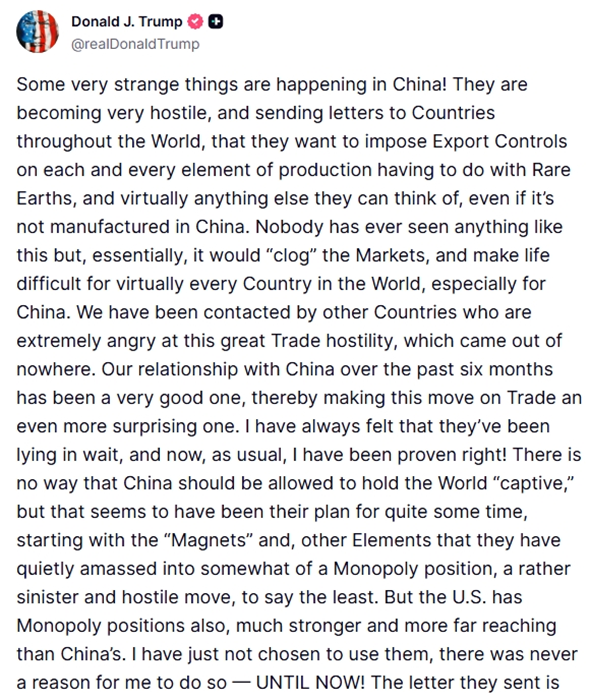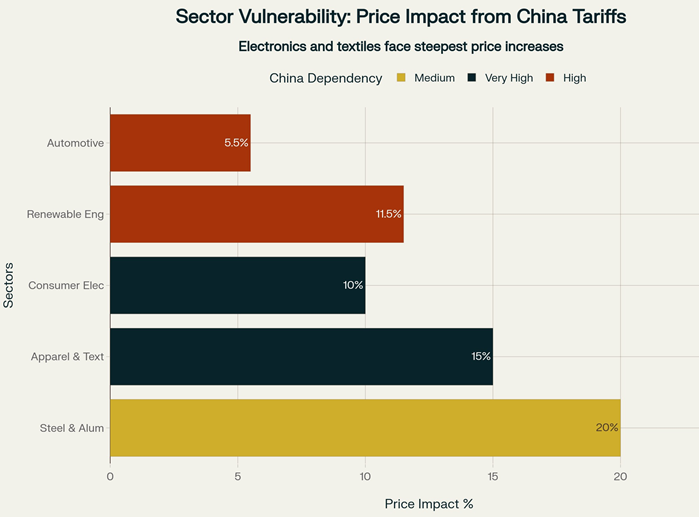S&P 500 climbs, but Nvidia slip keeps lid on gains
President Trump just threw down the gauntlet. In a Truth Social post that rattled global markets, he threatened major tariff increases on Chinese products following Beijing’s rare-earth export crackdown. His message was clear: China may control critical minerals, but America has "monopoly positions also, much stronger and more far-reaching than China’s."
As Trump prepares to potentially cancel his planned meeting with Xi Jinping in South Korea, investors need to answer one question: How do you position for an economic conflict that could reshape global trade for decades?
The Numbers Tell the Story
The economic fallout from Trump’s proposed tariff escalation would hit fast. Research shows American consumers could face an additional 2-4% inflation surge over the next 18 months, just as the Federal Reserve thought it was getting price pressures under control. Core inflation, already running above the Fed’s 2% target, could rocket toward 6% by mid-2026.
The pain extends beyond grocery stores and gas stations. Economic models predict the tariff shock could slash U.S. GDP growth by 1.5-2% annually, effectively wiping out most economic expansion. That’s recession-level impact without the typical business cycle triggers.
While devastating the broader economy, tariffs would generate a government revenue windfall. Treasury coffers could swell by $400-500 billion annually, equivalent to 18% of all household income tax payments. It’s a wealth transfer from consumers to the government, funded by higher prices on everything from smartphones to sneakers.
Winners and Losers: The Investment Playbook
Smart money is already positioning for the chaos. This goes beyond trade policy. We’re watching a fundamental restructuring of global supply chains that will create distinct winners and losers.
The Automation Acceleration
Companies providing supply chain technology and automation are seeing accelerated adoption as businesses scramble to reduce China dependencies. Honeywell International (NASDAQ:HON) and Rockwell Automation (NYSE:ROK) are building order backlogs as manufacturers invest in U.S.-based production systems. This trend has 2-5 year staying power regardless of political changes.
Nearshoring’s Biggest Beneficiaries
Mexico emerges as the clearest winner. Companies with significant Mexican operations—like Caterpillar (NYSE:CAT) and General Electric—stand to benefit from USMCA advantages as production shifts from China. Southeast Asian manufacturers are also positioning for windfall gains, with Vietnam and Thailand seeing 25% increases in U.S.-bound trade flows.
The Domestic Manufacturing Renaissance
U.S.-based manufacturers with minimal China exposure become premium assets. Deere & Company (NYSE:DE) exemplifies this theme—American-made equipment with growing export potential as global buyers seek China alternatives. The challenge is finding pure-play domestic producers after decades of supply chain globalization.
Inflation Hedges Return
Traditional hedges against policy-induced inflation are seeing renewed interest. Newmont Corp. (NYSE: NEM) and other gold miners benefit from monetary uncertainty, while energy producers like Exxon Mobil Corp. (NYSE: XOM) gain from higher commodity prices and potential sanctions-related supply disruptions.
Sector by Sector: Where the Pain Hits Hardest
Consumer electronics face "extreme" vulnerability. Apple (NASDAQ:AAPL), despite ongoing production shifts to India and Vietnam, still depends heavily on Chinese manufacturing. Tariffs could add $200-300 to iPhone costs, testing consumer price elasticity at premium price points.
Automotive companies confront structural challenges. Ford Motor (NYSE:F) estimates tariffs could add $500-1,000 per vehicle in production costs. The industry’s complex supply chains—where a single car contains parts from dozens of countries—make quick substitution nearly impossible.
Apparel retailers like Target Corporation (NYSE:TGT) and Walmart (NYSE:WMT) face 10-20% price increases on clothing and consumer goods. However, these companies have shown remarkable agility in sourcing diversification, potentially limiting long-term damage.
The Federal Reserve’s Problem
Fed Chairman Jerome Powell faces an impossible choice. Tariff-driven inflation demands higher interest rates, but the economic slowdown requires accommodation. Recent comments from Fed governors suggest growing concern about inflation remaining above 2% through 2027, creating a prolonged stagflationary environment.
This puts pressure on rate-sensitive sectors. Real Estate Investment Trusts (REITs) and utilities could face headwinds as the Fed prioritizes inflation control over growth. Conversely, financial companies like JPMorgan Chase (NYSE:JPM) may benefit from higher interest margins if rates stay elevated longer.
The Geopolitical Angle
Trump’s threat to cancel the Xi Jinping summit signals this conflict may intensify before any resolution emerges. The timing, coinciding with China’s rare-earth restrictions and Middle East peace developments, suggests coordinated pressure tactics.
For investors, this means positioning for a longer, more complex trade war than many anticipate. The old globalized system won’t simply snap back after political tensions subside. Supply chain diversification, once driven by efficiency, now follows national security imperatives.
Regional Power Shifts
China’s 0.8-1.2% GDP impact from lost U.S. trade accelerates its pivot toward domestic consumption and alternative partnerships. Alibaba Group Holdings (NYSE:BABA) and other Chinese companies are already expanding in Southeast Asia and Latin America, creating new competitive dynamics.
European companies face collateral damage. ASML Holding (NASDAQ:ASML) and other tech exporters could see 15% declines in U.S. sales as retaliatory measures spread. The integrated global economy makes isolated trade wars nearly impossible.

Sector-by-sector vulnerability analysis reveals which industries will hit consumers hardest, with steel and aluminum facing 20% price increases despite only medium China dependency, while highly dependent sectors like electronics and textiles show significant but varied impacts.
Portfolio Positioning
A balanced approach allocates 40-50% to defensive positions: domestic-focused companies with minimal China exposure, inflation hedges including precious metals, and dollar-denominated assets benefiting from initial currency strength.
Opportunistic growth plays deserve 30-40% allocation: supply chain technology providers, automation companies, and alternative trade partner beneficiaries. These themes offer 2-7 year investment horizons as structural changes play out.
The remaining 10-20% belongs in speculative positions around negotiation cycles, currency momentum, and regional trade diversion opportunities.
What This Means for You
Trump’s tariff escalation threat represents more than trade policy. We’re watching a fundamental restructuring of global economic relationships. While short-term costs appear substantial, the long-term implications may prove more significant than immediate GDP impacts suggest.
The winners will be those who adapt quickly to the new reality: companies that successfully navigate supply chain complexity, investors who position for structural rather than cyclical changes, and nations that capture diverted trade flows.
As Trump noted, there may be "no reason" to meet with Xi given China’s "hostile" actions. This suggests the economic conflict will intensify before any diplomatic resolution emerges.
For investors, the message is clear: The old rules no longer apply. Position accordingly for a longer, more complex economic war than most currently anticipate.
